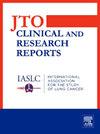手术切除的非小细胞肺癌的辅助化疗奥西替尼的成本-效果
IF 3.5
Q2 ONCOLOGY
引用次数: 0
摘要
奥西替尼现已被批准作为EGFR突变的IB至III期NSCLC的辅助治疗。然而,这种治疗既漫长又昂贵。其单药与联合化疗的成本效益情况尚不清楚。在这种情况下,我们研究了辅助奥希替尼加化疗和不加化疗治疗非小细胞肺癌的成本效益。方法建立一套马尔可夫模型,预测不同方案的成本-效果。数据来源于ADAURA试验的出版物和方案。健康结果被量化为质量调整生命年(QALYs)。成本和增量成本效益比(ICERs)分别以美元(USD)和每QALY美元估算。进行了确定性和概率敏感性分析。来自监测、流行病学和最终结果项目的数据被用来预测美国医疗保健系统的额外费用。结果与单独化疗治疗相比,奥西替尼联合化疗治疗获得5.86个QALY,增量成本为414,607.69美元(ICER = 380,347.85美元/ QALY)。单独使用奥西替尼治疗产生6.63个QALY,增量成本为402,224.32美元(ICER = 213,447.59美元/ QALY)。只有当每个QALY的支付意愿阈值达到或超过20万美元时,奥西替尼才可能具有成本效益。奥西替尼的价格对成本-效果的影响最大。根据监测、流行病学和最终结果项目的数据,这些做法可能会使美国医疗保健系统每年额外花费89亿美元。结论仅在患者支付意愿高的情况下,单独使用奥希替尼辅助治疗比联合治疗更具成本效益。奥西替尼价格的降低将改善其成本效益。本文章由计算机程序翻译,如有差异,请以英文原文为准。
Cost-Effectiveness of Adjuvant Osimertinib With and Without Chemotherapy for Surgically Resected NSCLC
Introduction
Osimertinib is now approved as adjuvant therapy for stage IB to III NSCLC with EGFR mutations. Nevertheless, this treatment is lengthy and expensive. Its cost-effectiveness profile as monotherapy versus combination with chemotherapy is unknown. In this context, we investigate the cost-effectiveness of adjuvant osimertinib with and without chemotherapy for NSCLC.
Methods
A set of Markov models was established to predict the cost-effectiveness of these different regimens. Data were sourced from the ADAURA trial’s publications and protocols. Health outcomes were quantified as quality-adjusted life-years (QALYs). Costs and incremental cost-effectiveness ratios (ICERs) were estimated in U.S. dollars (USD) and USD per QALY, respectively. Deterministic and probabilistic sensitivity analyses were performed. Data from the Surveillance, Epidemiology, and End Results Program were used to predict additional costs to the U.S. health care system.
Results
Compared with treatment with chemotherapy alone, treatment with osimertinib plus chemotherapy yielded 5.86 QALYs with incremental costs of $414,607.69 (ICER = $380,347.85 per QALY). Treatment with osimertinib alone yielded 6.63 QALYs with an incremental cost of $402,224.32 (ICER = $213,447.59 per QALY). Osimertinib is only likely to be cost-effective if the willingness-to-pay threshold per QALY is $200,000 or more. The price of osimertinib had the strongest influence on cost-effectiveness. On the basis of Surveillance, Epidemiology, and End Results Program data, these practices may cost the U.S. health care system an additional 8.9 billion USD/year.
Conclusions
Adjuvant osimertinib alone is more cost-effective than combination therapy, but only if the willingness-to-pay is high. A reduction in the price of osimertinib would improve its cost-effectiveness profile.
求助全文
通过发布文献求助,成功后即可免费获取论文全文。
去求助
来源期刊

JTO Clinical and Research Reports
Medicine-Oncology
CiteScore
4.20
自引率
0.00%
发文量
145
审稿时长
19 weeks
 求助内容:
求助内容: 应助结果提醒方式:
应助结果提醒方式:


